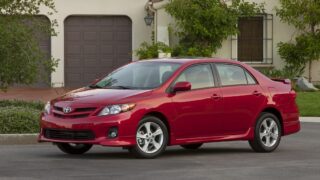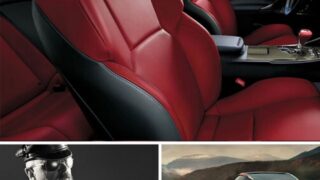From Question Mark to Landmark – Lexus Celebrates 20 Years
 When Lexus introduced the LS 400 luxury sedan and ES 250 entry-luxury
When Lexus introduced the LS 400 luxury sedan and ES 250 entry-luxury
sedan at the 1989 North American International Auto Show in Detroit,
the primary question was whether a luxury brand from Toyota could
compete in the U.S. luxury market.
Now, 20 years later, Lexus
has proven that it can not only compete in the industry, it can lead
it. And it’s done that by listening to customers and exceeding their
expectations every step of the way. Lexus was created in response to
Toyota owners’ wishes for a car that had the quality of their Toyota,
but came in a more luxurious package. Since the first Lexus vehicles
rolled out of dealers’ showrooms in September 1989, Lexus has emerged a
leader in quality, innovation and, most importantly, in customer
satisfaction.
This pursuit of perfection began in the early
1980s when then-Chairman Eiji Toyoda challenged a group of engineers to
develop the best luxury car in the world. Hundreds of prototypes and
thousands of test miles later, the LS 400 emerged.
Customers
flocked to the 80 carefully selected Lexus dealerships across the
country and read media reviews that included Automobile Magazine saying
the LS 400 “had come about as far toward the achievement of true
automotive perfection as we could come.” Car and Driver said “the Lexus
transports you literally and figuratively into another dimension.”
Motor Trend stated “we are frankly astounded that the LS 400 is this
great.”
But just as Lexus was gaining speed, it hit a
roadblock. Shortly after the launch, two minor quality issues were
discovered in the LS 400. A few people complained that the third
high-mounted stoplight was not as bright as it should be and one
customer complained about a cruise-control malfunction.
Lexus
faced the challenge head-on. It recalled all 8,000 vehicles that had
been sold, picked them up from their owners, fixed the problem and
returned the cars washed, with a full tank of gas. Owners also received
a gift as a thank you for their understanding.
Instead of
stopping the young brand in its tracks, this unprecedented customer
outreach established a new level of customer service that propelled the
brand even further.
In 1991, Lexus introduced an all-new ES
300 as well as the SC 400 and SC 300 sport coupes. By this time there
were 141 Lexus dealers across the country and Lexus outsold both
Mercedes-Benz and BMW to become the best-selling luxury import brand in
the U.S.
Through the early 1990s, Lexus continued to hone its
brand and its products, as reflected by quality and customer service
awards from J.D. Power and Associates. Lexus also introduced the GS 300
luxury sport sedan in March 1993.
But by 1995, Lexus was facing
some new challenges. The economy was weakening, the yen was fluctuating
against the dollar, and Lexus spent months in flux as the U.S. and
Japanese governments negotiated on proposed 100 percent tariffs on
Japanese luxury cars.
The tariffs didn’t happen, and the
overall luxury market kept on growing. Lexus brought out the LX 450
luxury sport utility vehicle in 1995 and new versions of the ES in 1996
and the LS and GS in 1997.
Then, in 1998, Lexus showed how it
uniquely listened to customers. When talking to customers about their
SUVs, owners consistently said, “I love my SUV, but….” Lexus heard
about rough rides, difficult entry/exit and a lack of luxury. To solve
those issues, Lexus introduced the RX 300 in 1998, which created the
luxury crossover segment. Ten years later, the RX continues to be the
segment leader. The same year, the new LX 470 luxury sport utility
vehicle debuted. In July of that year, Lexus had higher monthly sales
than any luxury competitor – a first for any international automaker.
Lexus became the top-selling luxury brand in the United States in 2000,
a title it has held for nine consecutive years.
In the early
part of its second decade, Lexus starting moving beyond its traditional
segments to introduce new vehicles to people who may not have
considered Lexus previously. In July 2000, Lexus developed a second
offering in the entry-luxury sedan category with the IS 300 sport
sedan. The next year, Lexus updated its classic SC model and turned it
into a hardtop convertible. The GX 470 mid-size luxury sport utility
vehicle was added to the stable in 2002.
With its extensive
selection of sedans, luxury utility vehicles and a hardtop convertible,
Lexus was offering products in nearly every luxury segment. It was time
to start demonstrating Lexus’ passion and its pursuit of innovation.
Lexus
made its mark by introducing the world’s first hybrid luxury vehicle.
The RX 400h went on sale in April 2005. With its lower emissions,
improved fuel economy and outstanding luxury, it demonstrated that
eco-conscious buyers didn’t need to sacrifice luxury to be kinder to
the earth.
Lexus’ second hybrid offering, the GS 450h hybrid
luxury sport sedan, went on sale in April 2006, and the LS 600h L
premium hybrid sedan, the world’s first full V8 hybrid vehicle, went on
sale in July 2007.
While Lexus’ image was definitely shifting from
its traditional attributes of being reliable and luxurious, it still
needed something to showcase its passion for performance. The IS F
high-performance luxury sedan was just the answer. Powered by a 416-hp
V8 engine, the Lexus IS F was the most uncharacteristic car Lexus had
ever built, and it demonstrated that the brand really could make a car
for high-performance enthusiasts. For those customers who wanted more
performance on their standard IS 250 or IS 350 sport sedans, the
company responded by introducing the F-Sport performance accessories
through dealerships.
Whether it’s making performance parts,
introducing new and exciting products, or treating each customer as a
guest in our home, Lexus’ pursuit of perfection comes through.
Today,
Lexus has 226 dealers who have invested billions of dollars in creating
state-of-the-art facilities and services to ensure that customers
continue to drive the division. The information gathered from dealers,
as well as from luxury customers across the country, feeds back into
everything Lexus does.
Now, as Lexus gears up for its 20th
Anniversary, it will once again be demonstrating how it can lead the
industry by listening to customers. In spring 2009 the next-generation
RX 350 luxury utility vehicle will go on sale, with the RX 450h luxury
hybrid going into production a few months later. Just in time for
summer 2009, Lexus will offer the all-new IS 250C and IS 350C
convertible versions of the popular entry-luxury sport sedan.
In
late summer 2009, Lexus will bring its fourth hybrid to market. The HS
250h will be the world’s first dedicated luxury hybrid vehicle, meaning
it’s not a hybrid version of an existing product. It will provide
enhanced fuel economy and lower emissions while giving customers the
luxurious features they’ve come to know from Lexus. It will be the
perfect vehicle to kick off Lexus’ third decade of pursuing perfection.
Credit: Lexus USA
Copy by: Flipside909




